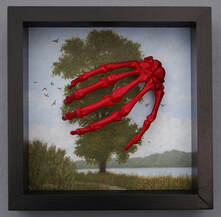 I moved to South Carolina last fall, and have now started forays into exhibiting on the East Coast. First up is the perfect opportunity to show one of my assemblage/painting pieces, an exhibit at the d'Art Center in Norfolk, Virginia, called "Eccentric: a National Exhibition of Surreal Artworks and Unconventional Materials". The co-curators, gallery manager Amanda Bradley and exhibition juror Alison Stinely, chose "Taking it With Us", a piece combining a glittery skeleton hand with a bucolic oil painting of a landscape in a shadow box (10" x 10" x 2 1/2"). After a delay due to the Coronavirus shutdown, the exhibit will be on view June 11 to 27, 2020. For more information, go to d'Art Center.
2 Comments
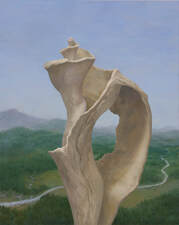 I was surprised to realize that my husband and I have been in Seattle for 20 years now. Living here has been a wonderful experience. The beautiful environment has been an inspiration for my art, and the people in the art community welcoming. I have participated in lots of exhibits at the Fountainhead Gallery and other spaces, and been impressed with the cultural scene here. In preparing to move back to the South and forge ahead with the next chapter in my life, I am enjoying pulling out of storage and reacquainting myself with paintings that didn’t find a buyer the first time around. Some have never been exhibited. I’m hanging them throughout the house and inviting art lovers to visit, browse and take advantage of this unique opportunity to purchase an artwork at a discount before I leave the Northwest. There will be a variety of sizes and subjects representing my various preoccupations. The larger paintings are framed or ready to hang, and I also have many unframed works for you to frame to suit your taste. I will have bins of figure studies to choose from, painted from the many lovely life models I have had the pleasure to work with. David and I will also offer for sale some artworks from our private collection, and artistic home furnishings and décor. Please contact me if you can’t make the event and would like a private showing. You can see some examples of artworks and prices here. Special Studio Sale: Sunday, July 14, 2019, 10 a.m. to 5 p.m. 1416 N. 35th St., Seattle WA 9810 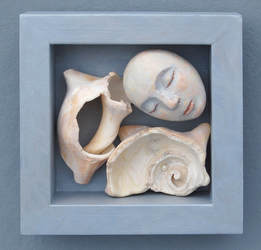 Keeping Secrets, 6" x 6" x 2" Keeping Secrets, 6" x 6" x 2" I am excited to be exhibiting my new type of artwork at Fountainhead Gallery in Seattle for the month of June. I will be exhibiting along with three other artists June 7 through 30, with an opening reception Saturday evening June 9 from 5 to 7 p.m. These new shadowbox artworks evolved from my desire to make something with my collection of natural objects. The eroded seashells, corals, limestone deposits and bits of driftwood that I pick up on the beach have such pleasing sculptural forms that I consider them works of art on their own. I was tempted to present them on pedestals with no artistic intervention. Removing the object from its original environment puts it into a new context and can generate appreciation for its abstract form, curiosity about what it is, and what its symbolic meaning is. In arranging and juxtaposing the objects I soon started to see them as players in a mysterious drama. My late mother was an accomplished artist who created paintings, sculptures, theatrical works and children’s books. Having studied at the acclaimed experimental art school Black Mountain College, she was constantly trying new techniques, despite the limitations of living in a small Southern town. Puppetry was a medium she had a love for since childhood, with which she could combine the skills of building the puppets and sets along with writing the plays. She eventually formed a troupe which traveled regionally, presenting her original works. As a teen I was prevailed upon one summer to perform one of her plays. While I admired my mother’s expressive style and have painted my own versions of one of her motifs, the broken conch shell, my own artistic temperament is more restrained and classically inclined than hers. Having thought of myself as a creator of two-dimensional art, I was surprised to find myself making constructions that could be seen as small theaters, with found and crafted objects acting as setting and characters. It felt entirely natural to sculpt small heads to include, and I recalled making puppets with the other children in a workshop my mother taught. The disembodied heads are not making their first appearance in my work. In the 1990s I was painting surrealistic scenes in which the egg-shaped, disembodied head represented the subconscious or dream state. It has a pleasing form and introduces a human element into a composition. In these new works, it represents a meditative state or a place to which the mind has traveled. In addition to the sculptural, natural and found elements, I am incorporating landscape painting as a backdrop in some of the constructions. I have primarily exhibited landscape paintings for several years. In the interest of recycling, in a few shadowboxes I use sections of older paintings. Creative re-use and a reluctance to add to the waste stream are growing concerns of mine. These works evolved organically into scenes from stories without words, involving the cycle of life, nature and psychic states. I will be interested to see what my audience thinks of them! 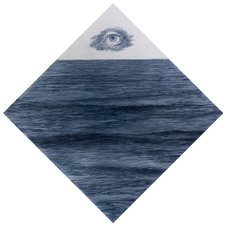 I am pleased to have a painting selected by guest juror Deborah Paine for the annual Center on Contemporary Art members' show. CoCA's exhibits are always lively and progressive, and usually include something you've not seen the likes of before. While the Seattle organization has been around for years, it has had to move its physical space around a lot, and I have been impressed at its tenacity in presenting ambitious exhibits in difficult economic times. The new gallery space is in the Toshiro Kaplan building (114 3rd Ave. S.) in Pioneer Square and has been freshly renovated. There will be an opening reception during the monthly artwalk, Thursday April 6, from 6 to 9 p.m. The show will be up until Saturday, April 29. For more information, see the webpage at CoCA Members' Show . At left: Flood, oil and aluminum leaf on panel, 14" x 14" 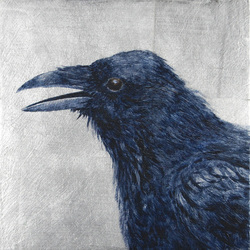 The Raven Speaks, 6" x 6" The Raven Speaks, 6" x 6" Each December the Fountainhead Gallery hosts a group show of gallery artists, with an inspirational theme. This year the theme is "Celebrating the Poetic Heart," and artists were asked to submit works that were inspired by a poem. I admire poetry, but don't read much of it. While painting, I often fixate on music and the poetry and creativity in a lyric, and I happened to have a new piece I made while thinking about a song by the Pixies. I will be exhibiting it and a few other new tiny works, which are a departure from the paintings in my recent exhibits. These combine oil painting with metal leaf in silver, gold or aluminum. I have been experimenting with both translucent paint on top of the leaf, and with the more traditional method of gilding only the background. For subject matter, I am continuing to be drawn to the surface of the sea and also to sea creatures and birds. The exhibit will run December 1 - 23, and there will be an opening reception with music, refreshments and poetry readings on Saturday, December 3 from 5 to 7 p.m. All are welcome. For more information, call 206-285-4467, or go to Fountainhead Gallery. 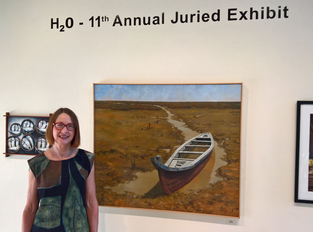 My large painting Mired (oil on canvas, 34” x 40”) has a prominent location in the installation of the Columbia City Gallery’s annual juried show. The exhibit has the theme “H2O: What is it worth?” and was juried by Greg Lundgren (curator), Merica Whitehall (Executive Director of the Nature Consortium), and Vaughn Bell (environmental artist). The chosen artworks are diverse in media and style, ranging from conceptual projects, to sculptures in materials both ancient and modern, to traditional oil painting. The ideas represented are similarly wide-ranging. The opening reception August 20 was well-attended. It is well worth a visit to the charming Columbia City neighborhood to see the show before it closes September 25. The gallery is located at 4864 Rainier Avenue South, Seattle 98118. Phone: 206-760-9843. During the past year I spent some months experimenting with media such as metal leaf, pondering making sculptural constructions, and painting the figure model. But when it came time to settle down and choose a theme for my next show at Fountainhead Gallery, I was pulled back to painting sea, sky and rock. As I point out in my artist’s statement, this subject matter, while representational, is contemplative and lends itself to minimalism, manipulations of composition and experimentation with color. I have admired the work of Vija Celmins, whose highly rendered drawings of the surface of the sea are impressive technically and conceptually. I was challenged to do my version, the result being “Deep Blue”, 30” x 40”, with a large sea surface and a high horizon line. As a companion, I composed “Traversing the Unknown”, a seascape with a low horizon line and a massive cloud picking up varied colors of the setting sun. I don’t like to repeat myself; I tend to proceed in a theme and variation manner when composing new works. 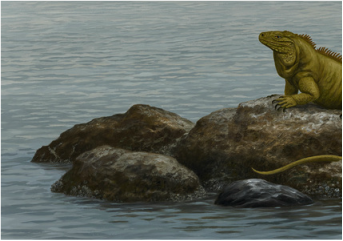 detail, Realm, oil on canvas, 32" x 26" detail, Realm, oil on canvas, 32" x 26" In 2006 my husband and I toured the Galapagos Islands for a week in one of the smaller available tourist boats and were properly impressed by the primordial scenery and wildlife. The islands were composed of jagged outcroppings of volcanic rock, and the birds and animals were unafraid of humans. We were able to get close to the iconic giant tortoises, sea lions, marine iguanas, blue-footed boobies and even nesting albatross. The Ecuadorian government has established policies to reduce the impact of current tourism and to ameliorate damage from past exploitation. I carried a little sketchbook and watercolor set along with my camera and captured a small portion of the wonderful experience, but had not made use of any of the images until recently. Having made a painting of a rugged part of the Olympic Peninsula coast for my exhibit last year, I continued with three based on scenes of rocks jutting from the sea in the Galapagos. I recall one particularly thrilling dawn, when our boat sailed through a narrow passage between two towering spires. Also in this show is a painting of an iguana isolated on a tiny island of rocks (Realm, 32” x 26”). I chose a green (land) variety of iguana for my protagonist; the marine variety are phenomenally ugly. Having created several compositions of rocks surrounded by sea, for the last painting I finished for the show, I chose to depict water surrounded by rock. In some parts of our world, the coasts are being inundated by rising seas, in others drought is leaving precious little water. A location I visited in Iceland in 2011 provided a good illustration of this—a deep crater in the rocky, treeless terrain, filled with a mysterious pool of water. I added one of the hardy Icelandic ponies to the scene (Iceland Eye, 30” x 24”). This describes a few of the ten paintings in “Vistas”, which will be on view at the Fountainhead Gallery, 625 W. McGraw St., Seattle, from June 2 to 25, 2016. Also exhibiting are Jennifer Frohwerk with narrative interior scenes and still life artist Beth Flor. There will be an artists’ reception open to the public on Saturday, June 4, from 5 to 7 p.m., and all are invited. Many artists consider representing the human form to be the ultimate challenge, and I am one of them. Artists who specialize in portrait and figure painting strive for years to master it, and have to keep practicing just as an athlete has to exercise. Even artists who normally exhibit only landscape, still life or abstract art will return to sketching the figure from time to time. It’s hard to find friends who are willing to sit still and be stared at for hours, and hiring a professional artist’s model is expensive. We are lucky in Seattle to have several group studios at which to practice drawing and painting from a nude, portrait or costumed model on a regular basis. I like to go to the Open Studio sessions at Gage Academy of Art when I can. They commonly schedule short pose or long pose (3 hour) sessions almost every day, and are open to artists on a drop-in basis for a reasonable fee. 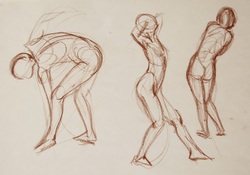 At short pose sessions, poses range from less than a minute to 20 minutes. Quick drawings are called “gesture drawings” and the goal is to capture the flow of the pose, the feeling of the weight and pull of the model’s muscles, in a few lines. The artist should almost become the model. These are valuable to train the eye and hand to respond intuitively to the subject. In the longer poses one can spend more time measuring proportions and angles, and then adding details and shading, but I believe the initial gesture sketch is still the most important element in capturing the gestalt of the person before you. Sometimes an art school or group of artists will hire a model to repeat a pose for an extended number of sessions so they can complete a more resolved study. I have attended a few of these, and use the sessions to try out various approaches to painting form—systematic classical processes like drawing first, proceeding with monochrome paint, then layering of color, etc.; or direct processes such as alla prima, with brush drawing and using full color from the start. Often I find myself diverging from my initial plan as the painting evolves, from lack of patience or changing goals. Painting with a group of other artists and responding to the figure in front of you is different from working alone in one’s studio. There is the camaraderie of the other artists, with whom you can share painting tips, and there is the personality of the model. Some are more talkative and open about their lives, and others are strictly business. I think of him or her as an actor on stage, and for a successful painting, I must imply a mood or a bit of a story to make the scene interesting. A painting or drawing of a figure model “just” standing or sitting there can be a fine thing if skillfully rendered, but it needs something special to transcend being an exercise in anatomy and to draw in the viewer if it is going to be exhibited. Some artists are able to do it with beautiful marks with the pencil or paint, or an interesting perspective; others can find something special in the expressiveness of the face or pose. 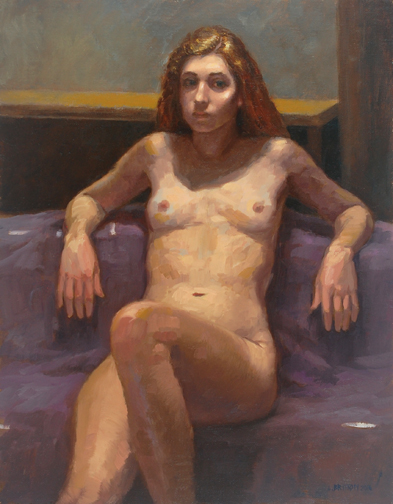 Earlier this year I attended a series of morning “reserved easel” sessions at Georgetown Atelier to paint a lovely young model. My strategy for this study was to do a drawing at the first session, getting the feel of the pose and deciding the composition of the painting. Next I loosely sketched the composition on a small linen-covered panel in charcoal and began to paint. I decided to keep the study monochrome until the shapes and values were fully resolved, and for this I used burnt umber and lead white. I spent two or three sessions on this; the lighting was challenging since my back was to a bank of large windows and the light and shadows changed dramatically as the sun rose and storms moved through, conflicting with the strong lamp above the model. I practiced using thicker paint and looser brush strokes, fighting my tendency to over-blend. During the final couple of sessions, I started adding color, but kept it muted, as there was not a lot of color in the scene. I started this study with no expectations other than a learning experience, and I am pleased with parts of the resulting painting. Right: Young Woman in a Shadowy Room, 16” x 12” 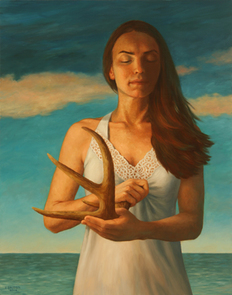 A few times I have hired a model to come to my studio and pose for more complex paintings. I used the model as an actor in a scene that had implied narrative, which was not fully pre-conceived but evolved as I worked with the model and then added background and other elements without her presence. In the end, the final product may not even look like the model as it takes on a life of its own. Two of these paintings that I made a few years ago will be hanging in an exhibit called “Figuratively Speaking” at Ida Culver House Broadview (12505 Greenwood Ave. N., Seattle), curated by June Sekiguchi. There will be a reception with wine, hors d’oeuvres and music on May 19 from 3:30 to 5:30 that is open to the public; please RSVP to 206-361-1989 by May 16 if you would like to attend. The exhibit will be up, in the lobby and public areas of the building, until September 11, 2016. Left: Sleepwalker, 2006, oil on canvas, 28" x 22" 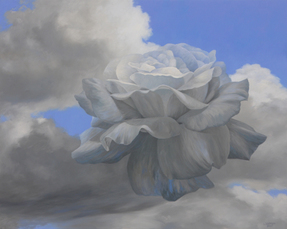 Cloudy With Chance of Teardrops, oil, 24" x 30" Cloudy With Chance of Teardrops, oil, 24" x 30" Every now and then, when perusing social media, I will come across a story or video about a blind artist. This brings up questions immediately: How do they do it? And also, why? Is it to show us the blind can do anything the sighted can, or is it a manifestation of creativity that can’t be expressed any other way? It’s an interesting topic to think about for a visually oriented person. I am taking part in a group exhibit at the Mount Baker Neighborhood Center for the Arts that includes at least one blind artist. This relatively new non-profit gallery in the Mount Baker ArtSpace Lofts building has a mission to bring together artists of all levels, and provides opportunities for artists with disabilities and the under-served community. I heard about their exhibit, “Flowers, Flores, Ubaxa,” through a call for art notice, and thought it would be an opportunity to put back on view one of my flower pieces from a few years ago. I occasionally participate in exhibits in neighborhoods in the greater Seattle area, in part because I have a good inventory of paintings and it’s gratifying to have them appreciated, and in part to explore and to meet the dedicated people working to put these shows together for their communities. When applying for this exhibit, I was intrigued to see they requested a visual description of the art along with the image, not the more esoteric artist’s statement. When I dropped off the painting in Mount Baker, I met the director, Barbara Oswald, who has very little sight, and she introduced me to a blind artist who would be exhibiting a painting for the first time. The artist had made a small acrylic painting of poppies floating on a blurred, textural background. The colors were unusual but harmonious, the contrast good, and she had achieved a delicate translucency in the petals. I learned from a casual search on the Internet that many people classified as blind can see a bit of light and form, which answers some of my questions. But there is one well-known blind painter in Turkey, Esref Armagan, who was born completely unsighted, and is self-taught. His work could be characterized as child-like or primitive, but the work of the late British artist Sargy Mann is quite sophisticated, despite increasing blindness that started early in his career. At the end of his life he was painting completely blind, by touch. As he said, so much of art goes on in the head. I also learned of a sighted artist, Roy Nachum, who incorporates poetic messages in Braille into his large oil paintings. The striking, realist images in minimalist color schemes have bumps sculpted under the paint so they can be read by touch. I wonder if, since color absorbs and reflects light at different wavelengths, if a method could be devised to experience color on a surface by variations in temperature. My own eyesight is not strong; I have worn glasses since second grade. A couple of years ago, I attended a touring Blind Café, where in a totally dark church basement, diners ate and listened to a concert, assisted by blind servers who shared their experiences with us. Those of us with normal vision are amazed by the skill with which the blind cope with everyday life, but they prefer we not be. When I try to imagine what I would do with my life were I to become blind, I assume I would concentrate my efforts on sculpture and/or music. Painting is difficult enough when I can see. But maybe it would be freeing, and take away some of the value judgement, to try it with the eyes closed. The exhibit “Flowers, Flores, Ubaxa 2016” will be at Mount Baker Neighborhood Center for the Arts April 1 through 28. There will be two receptions to meet the artists, Friday, April 1, from 4:30 to 7:30 p.m. and Sunday, April 3, from 3:00 to 6:00 p.m. The gallery is located near the Mt. Baker light rail station at 2919 Rainier Avenue South. 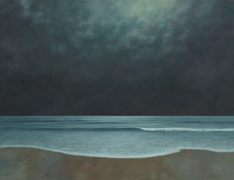 Murmur and Sigh, oil on canvas, 28" x 36" Murmur and Sigh, oil on canvas, 28" x 36" I have a painting included in Gallery 110's 6th Annual Juried Exhibit, which will be on view for the month of February. The exhibit was curated by Melissa Feldman, a faculty member of Cornish College of the Arts. After choosing from over 1,500 submitted works from around the nation (they used the Call for Entry online submission system), she titled the exhibit "Beam Me Up" and noted the process was "like receiving messages from sentient life on other planets." I imagine sorting through that many entries would be fascinating but exhausting. Trends she recognized included the "zen aesthetics of minimalism", which I would say my piece, Murmur and Sigh, represents. Gallery 110 is an artist-run, nonprofit space in Pioneer Square's Toshiro Kaplan building, one of the best places to find a full gamut of art in Seattle. The gallery has just been remodeled and will be fresh and bright for the installation of the new show. I look forward to seeing the other works in the exhibit. Other than regular hours, Gallery 110 will be open for the First Thursday Artwalk this week (Feb. 4) and there will be a reception and awards presentation on Saturday, February 6, from 5 to 7, to which the public is also invited. For more information, go to Gallery 110. |
AuthorHere I will keep you up to date on my exhibits and other artistic endeavors. Archives
March 2024
Categories |
 RSS Feed
RSS Feed